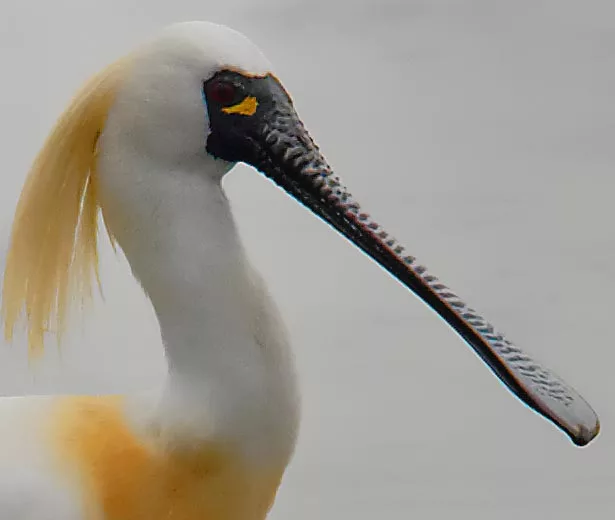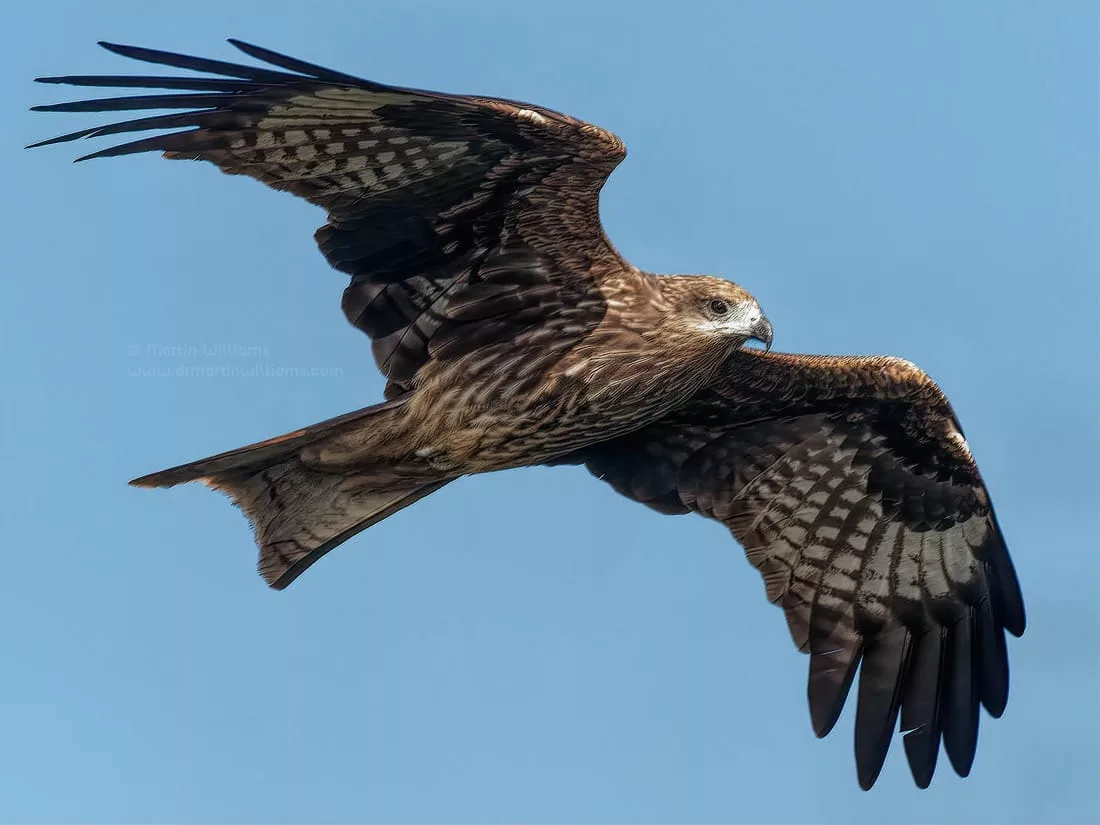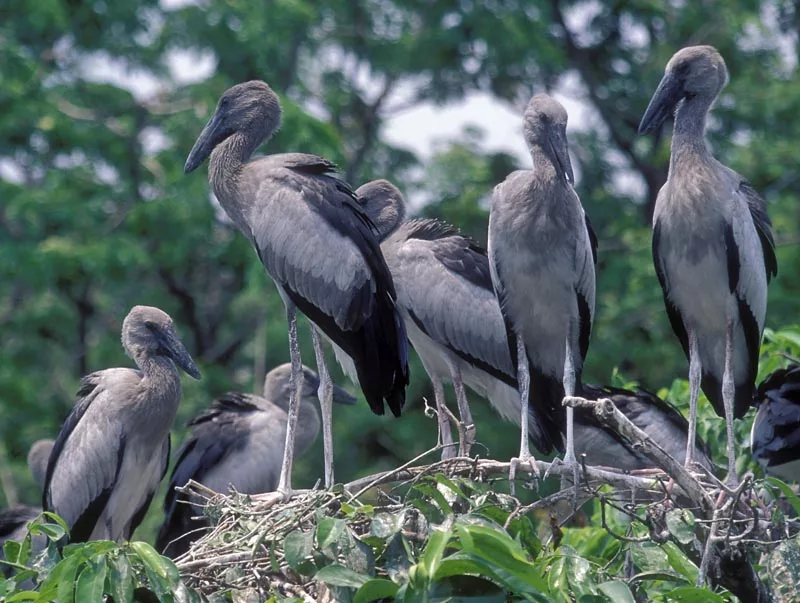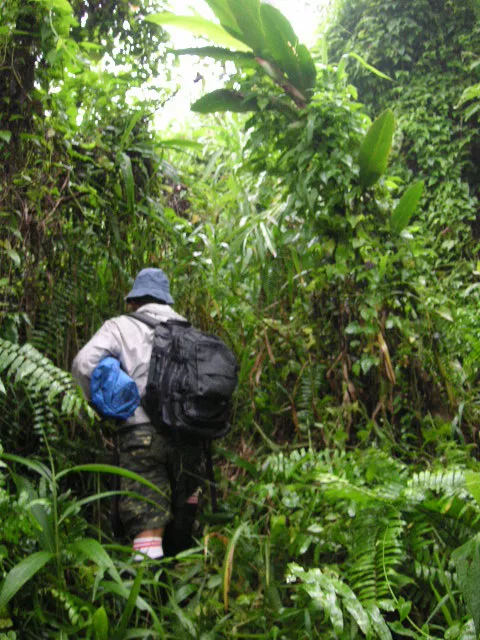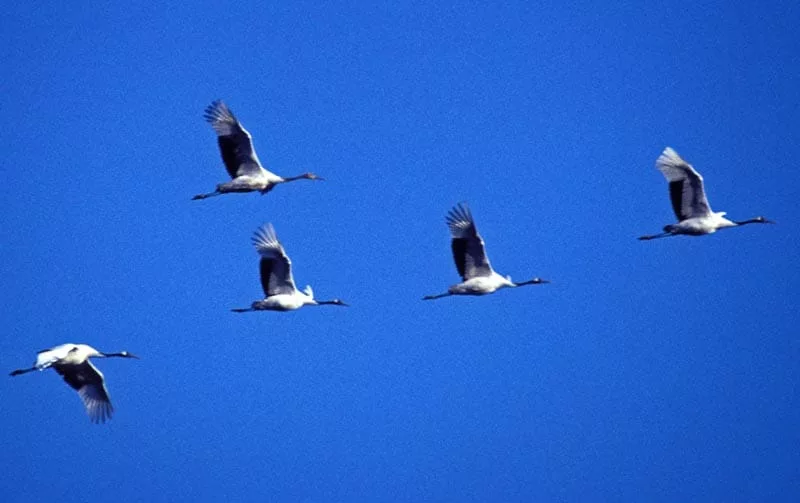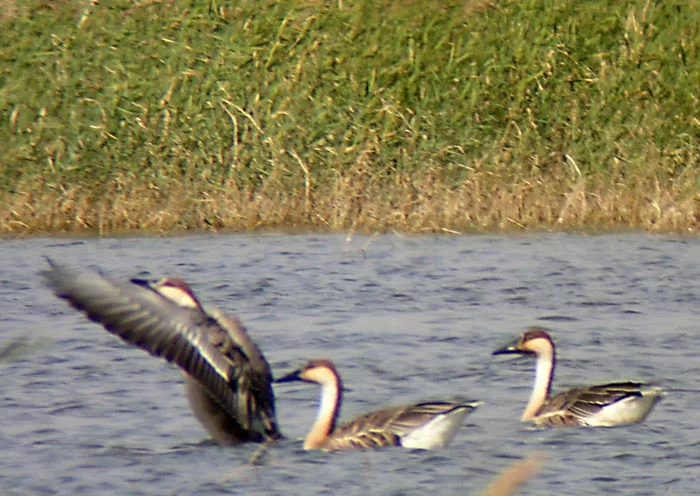Southwest Yunnan Birding Holiday
Martin, Maya and David Williams
This was a family holiday, with strong birding – and photography – elements [chiefly for Martin, main author here], from 24 March to 4 April 2016.
For most of the trip, we were very kindly guided by Cheung Ho-fai, former chairman of the Hong Kong Birdwatching Society, who now lives in Baoshan, west Yunnan and has a wealth of experience in the area. Ho-fai now aims to boost birdwatching and conservation in Yunnan.
Others have seen far more species, written more in-depth birding trip reports.
These notes are instead aimed at giving some impressions regarding places, along with conservation – especially the apparent value of bird photography tourism based on hides and feeding/watering stations for forest birds; plus a few questions that may be worth answering.
Gaoligongshan – Gao Family Mountains [Mountains] range
The Gaoligongshan range is akin to a southern spur of the Himalayas, running north-south along the west bank of the Nujiang [known as the Salween in Myanmar]. There’s a huge national nature reserve here; around 600km long, and with altitudes ranging from around 700-3916m. Habitats range from broadleaf sub-tropical forests to alpine shrubs and meadows, with rainfall mainly in summer: making for a huge diversity of plants and animals, including over 500 species of birds.
Gaoligingshan 1: Baihualing – Hundred Flowers Ridge
Easy Birding from Hides; Tougher Elsewhere
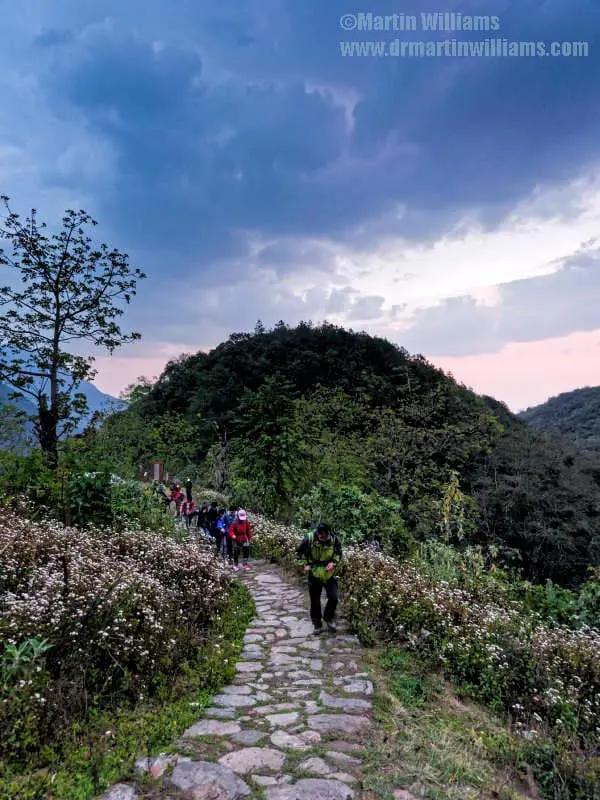
Baihualing village is the main base for visiting and exploring the reserve. Here, we stayed at the reserve headquarters, which has fair accommodation – a twin bed room with en suite bathroom for us, and a rather outsize looking building [education centre?] nearing completion. Could see reserve money being spent here; but up above could not really see evidence of money being spent for actually conserving the plants and animals – not even trails, signage other than along old Silk Road; an old shelter has been left to fall into ruins.
Just above the reserve hq is a village eco lodge, part of an “agricultural cooperative” project, which is also a place to stay and eat. [If you head to either place, note the village shops are very simple: best to bring up any biscuits, chocolate etc you might want for snacks while out and about.]
The village is on a hillside above the Nujiang valley, and reached by a relatively new metalled road. There’s something of a mini boom in ecotourism here, driven by bird photographers (most from within China – I met some from Taiwan, also a small party from Inner Mongolia who had made three trips here), also by hikers, some of whom make a 25km trek up and over a pass at 3200m, to Tengchong county to the west. This route is especially notable as it follows the Southern Silk Road – for trade between China and places like India to the west. Nowadays, all seems quiet at a small, high car park, surrounded by grassy areas and trees, yet a sign says it’s called Old Street and there used to be inns, restaurants and more there.
Though I readily find a description of “primeval forest” here, it appears to be mostly secondary. Given the history of being on southern Silk Road, would be unsurprising if much timber had been cleared in the past, for building etc etc.
Feeding and watering stations with bird hides: easy peasy
The best birding proved to be in forest above the village. Especially near and at the feeding and watering stations that have been set up in at least 30 locations, and are overlooked by small hides made from poles and netting. The foods for birds seemed to be mealworms plus some fruits; water was carried to some places in big plastic containers – and was surely especially welcome to birds as winter here can be dry, and days sometimes hot.
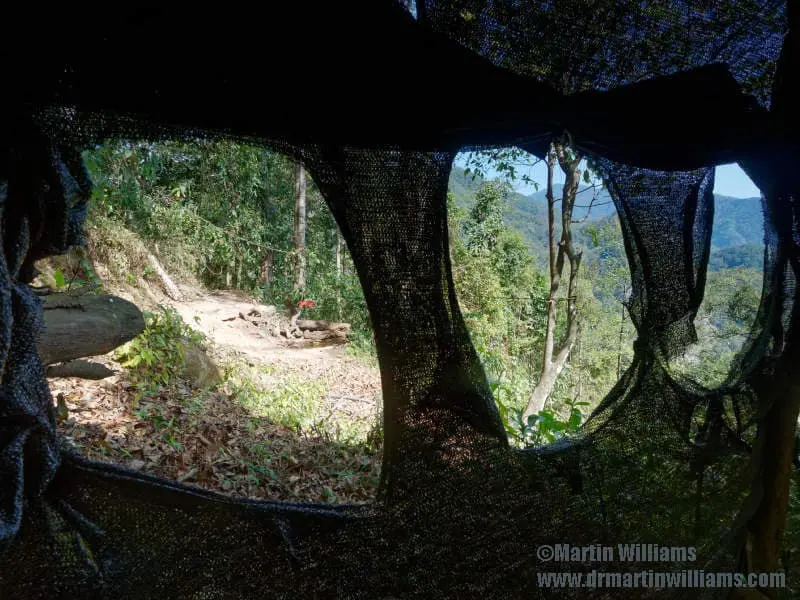
These hides offer the easiest way of seeing and photographing a remarkably wide range of forest birds, including notoriously skulking species like tesias and Gould’s Shortwing. It turned out that the man or men [only men?] operating each hide kept informed of visiting species, especially if any were notable and likely to interest bird photographers (birders being in the minority here). They know the names in Chinese.
Hides could be booked, perhaps a day in advance; the cost was per camera, and typically 40 yuan per camera, though one or two operators are somewhat breakaway, seeking more money. There were seats in the one hide I tried: sawn off logs, with cushions.
In front of hides, areas tend to be landscaped, in efforts to meet photographers’ demands – which often means getting unimpeded shots of birds, so might mean too much clearing if care is not taken.
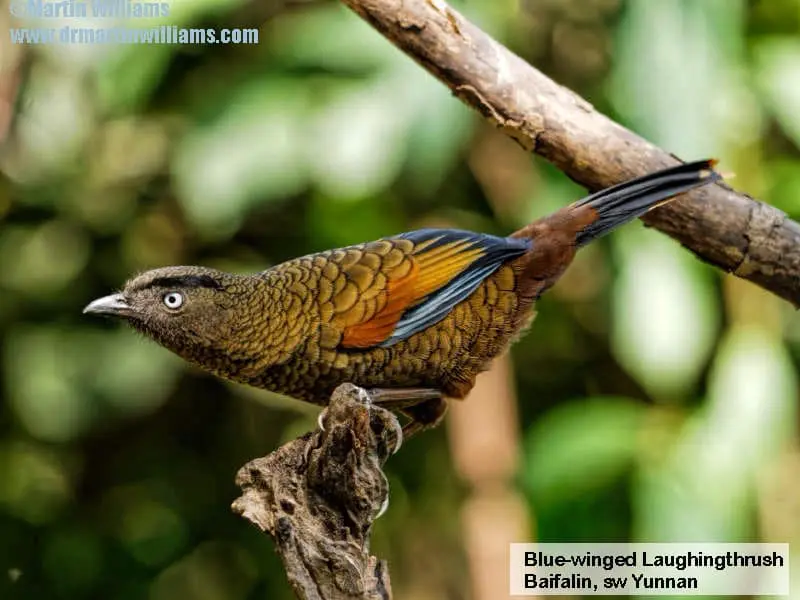
I was in two minds about hides: great for seeing birds and taking photos, yet somehow slightly “zoo like” – visit this hide for tesia, this one for shortwing etc etc. Also I can get fidgety, and I was keen to explore. So I spent most time walking; and only went in one hide for maybe two hours: it was remarkably productive, with photography helped by excellent light.
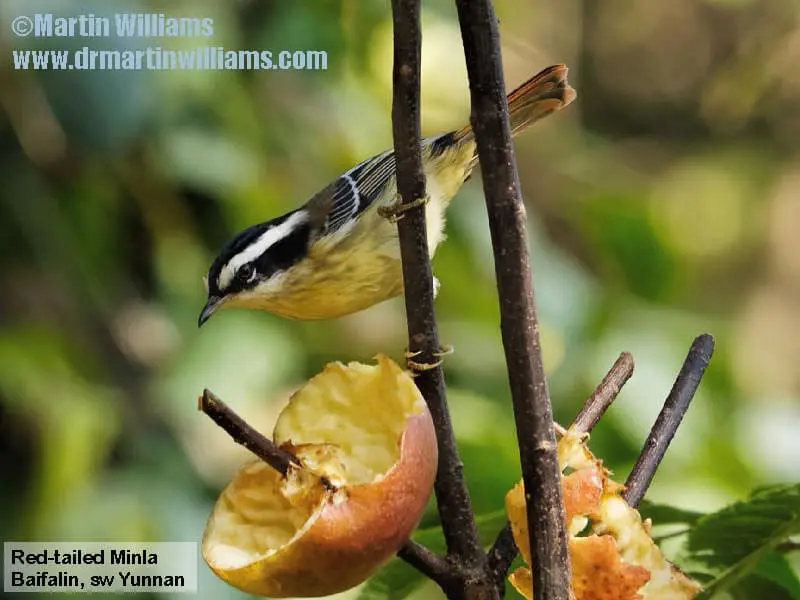
Birds coming to the hide included Rufous-fronted Barwing, Red-tailed Minla, Dark-throated Thrush, Blue-winged Laughingthrush [only place I saw this species], Red-tailed Laughingthrush, Large Niltava.
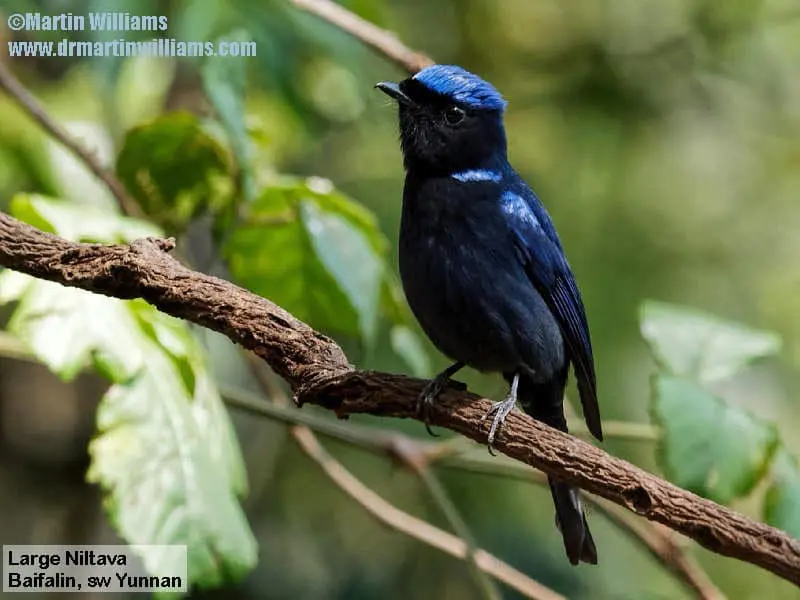
Walking in the forest with the hides, it was noticeable that while there were bird flocks (“waves”) at times, birds did seem concentrated near the hides: in at least one case, feeding on fruit/flowers with nectar just above, suggesting the hide site was carefully chosen. Some hides were surprisingly far from the dirt road above the village: maybe 300 metres or more in a few cases I guess. This has helped lead to there also being charges for carrying camera gear and tripods to and from hides; you can even order a lunchbox to be brought to a hide!
While the hides are set in very good forest, they are perhaps outside the reserve. At least, those I saw were below the small forest guard post.
Walking in the forest
The higher forest – up in the reserve proper – was quieter; indeed, it was hard to find birds at times.
Despite being driven up soon after dawn, I saw no pheasants – Mrs Hume’s or otherwise – along dirt roads. Partly as even at this time, the main dirt road was quite busy with trekkers and others also being driven up; but also, Ho-fai tells me pheasants are harder to see nowadays. Maybe, then, there is less bird protection away from the hides area.
There’s a deep ravine a little north of the village; two stone footpaths lead into it, and it’s possible to make a circuit by dropping down to the stream, following it, then leaving by the other trail: maybe 4 hours or more required. We only walked down the lower trail to the stream; not with so much time for birding, and mainly to see the stream and a hot spring pool.
The hot spring pool is a fun place for a warm bathe; hot spring waters are collected in a pool that locals have created using a simple stone wall. Next to it there’s a picturesque series of cascades, and about 20 mins further up – along a rather dodgy path – is a large waterfall [evidently a winter site for Scarlet Finch; I saw none, perhaps partly as too late in the season].
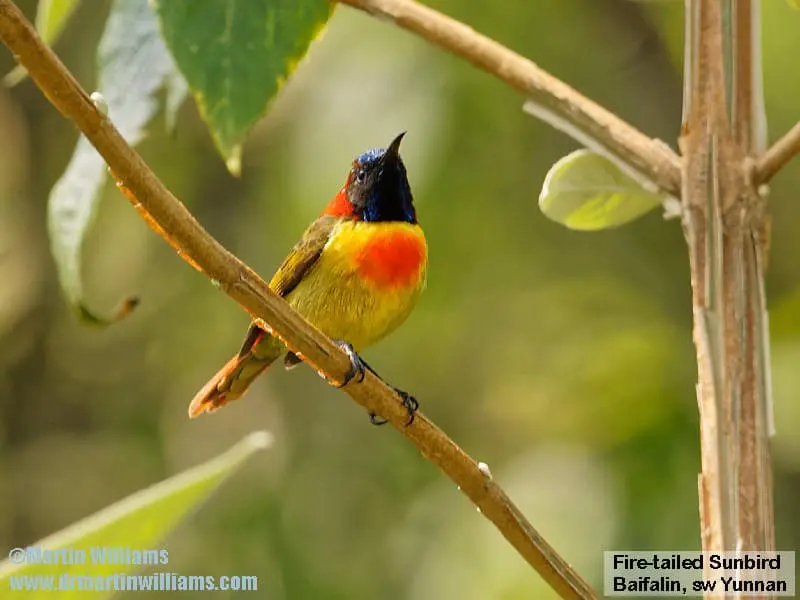
I greatly enjoyed spending time at Old Street, the high car park. It’s a wonderful vantage for overlooking the area, down to lowlands. A Black Eagle flew over fairly close.
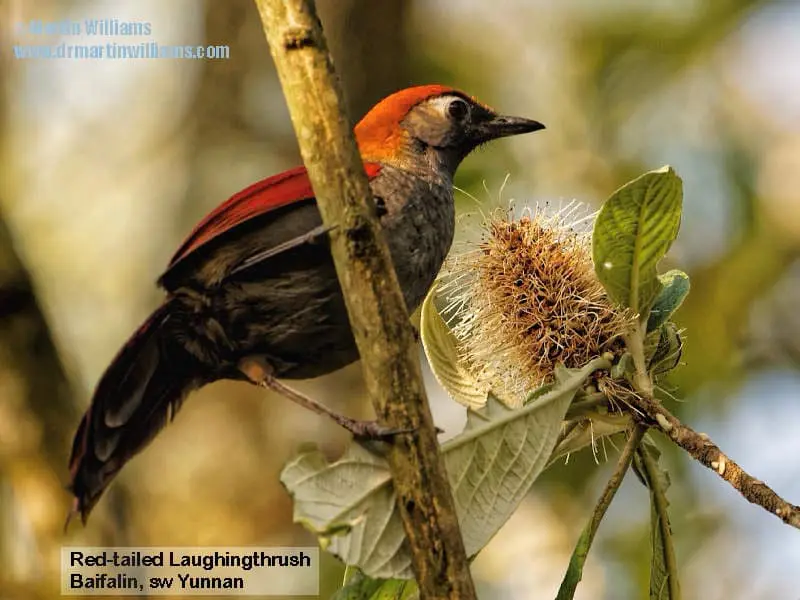
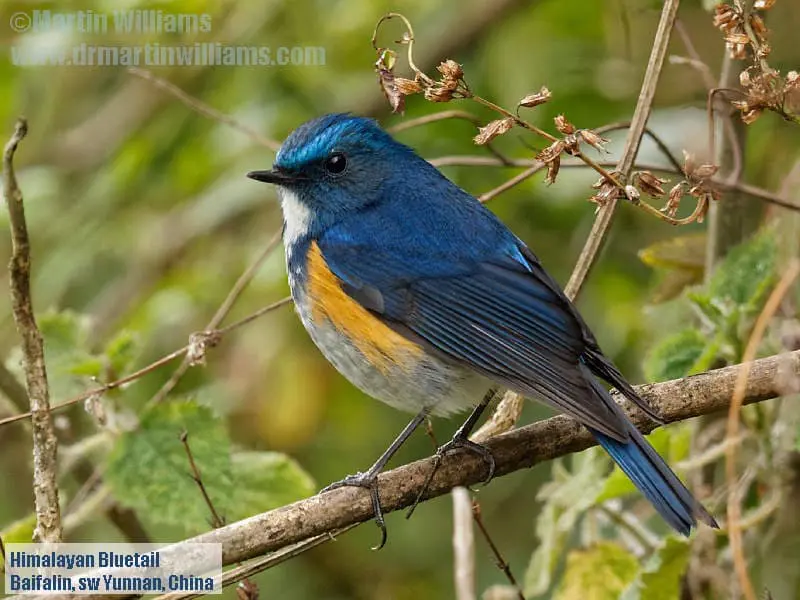
Also, there’s a cluster of trees that were in flower, attracting many birds to the nectar: especially Buff-barred Warblers, also Yunnan Fulvettas, an elusive Fire-tailed Sunbird, Red-tailed Laughingthrush. Himalayan Bluetails.
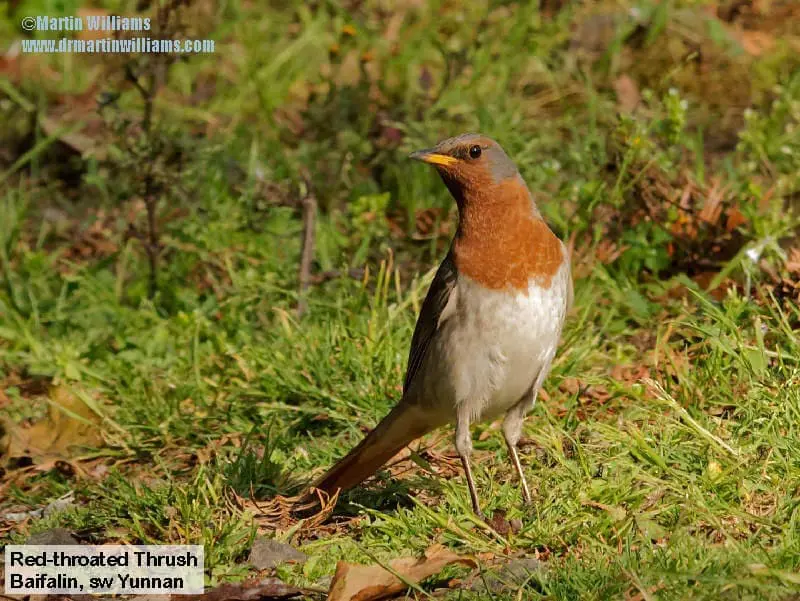
A male Red-throated Thrush was a surprise to me.
I also walked up the trail – the old Silk Road – from Old Street. Very, very quiet forest; but continued till I reached a somewhat level area, with signpost indicating this is the second stop along trail over the pass. A bird guide told me that can see birds including Cutia here, though it was a little early for the flowers and he’d seen few birds in recent days. It was pretty quiet there; two or three Beautiful Sibias, a pair of Gould’s Sunbirds put in brief appearance, and a Fulvous-breasted Woodpecker was calling from a distant tree.
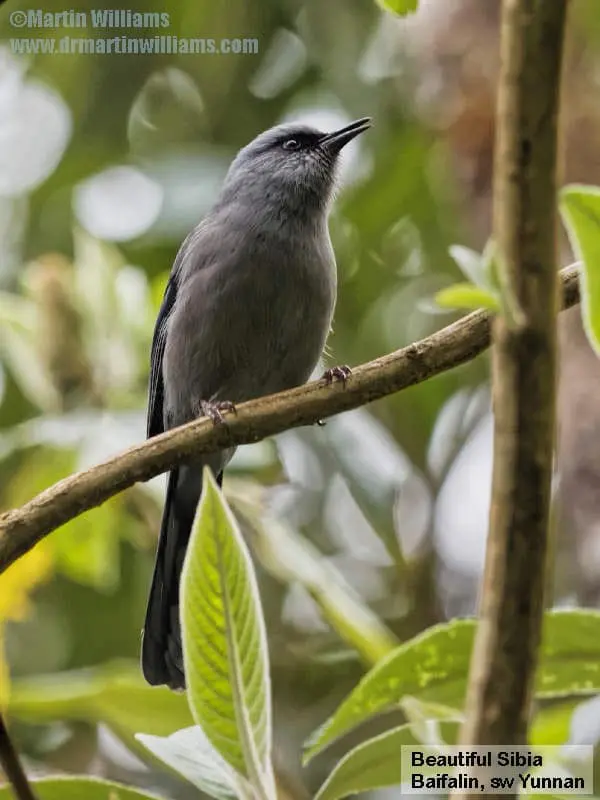
Pianma and Fengxueyakou, Gaoligongshan
We headed to places further north in the Gaoligongshan range, travelling alongside the Nujiang, then crossing up and over the Fengxueyakou – the Pass of Snow and Wind – to stay at Pianma.
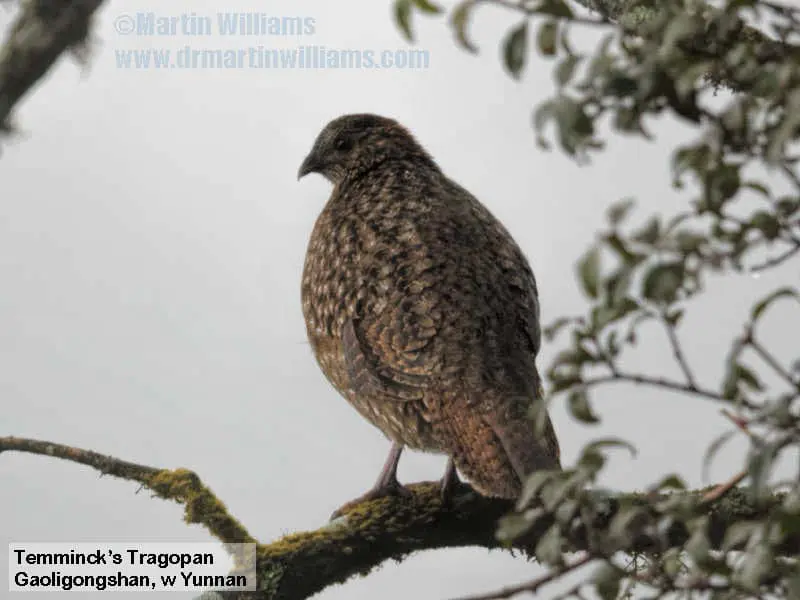
There was thick cloud/fog shrouding the pass as we drove up in the late afternoon. But – thanks to Hofai keeping a keen eye out, we were lucky enough to see a female Temminck’s Tragopan in a tree by the road, perhaps set to roost for the night.
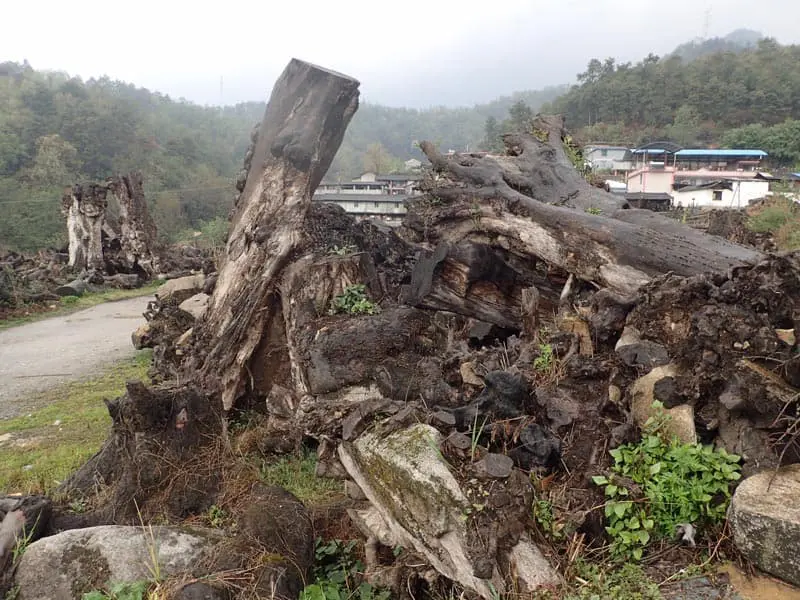
Pianma’s on the border with Burma; and has thrived in recent years due to trading timber from Burma. Yet while there’s a great road over the pass, with gentle inclines to aid heavy trucks, it seems the timber is illegally felled in Burma – and there has been a recent clampdown on trade. Hence, much quieter nowadays Hofai told us; though who knows if will stay like that.
Pianma’s also on “the Hump” – the route flown by Flying Tigers carrying supplies for Chinese forces fighting the Japanese army during World War 2, and there’s a museum there with this rebuilt plane – plus a gallery above the caretaker billed as “anti-British” for displays on a border dispute between British forces in Burma and local Chinese that started in 1911.
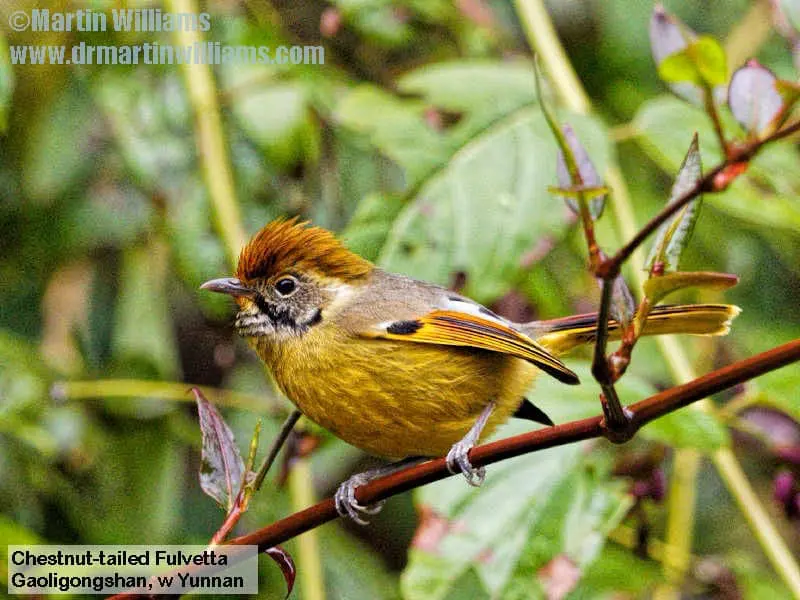
In the morning, there was still low cloud/fog over the pass, but had a chance for some birding in the forest above Pianma. There were a few parties of small birds, including Chestnut-tailed Siva…
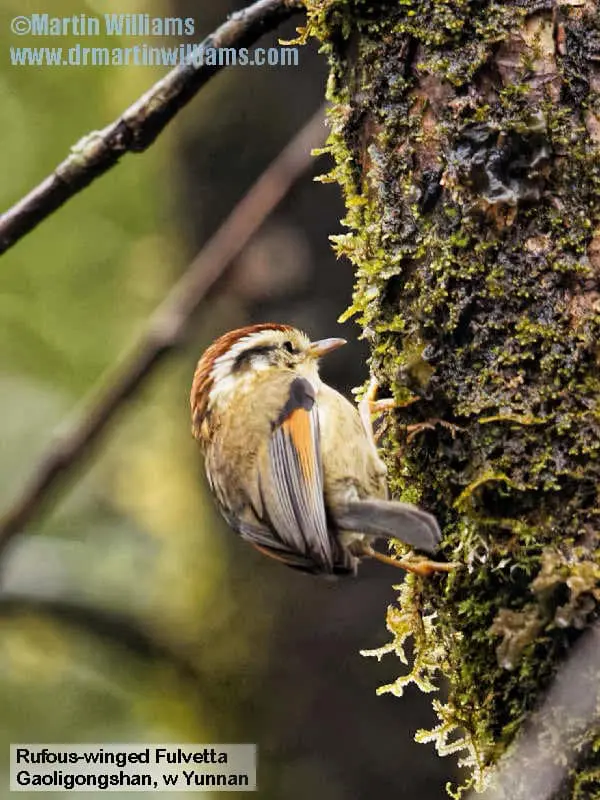
also Rufous-winged Fulvettas clambering around on branches and mossy tree trunks.
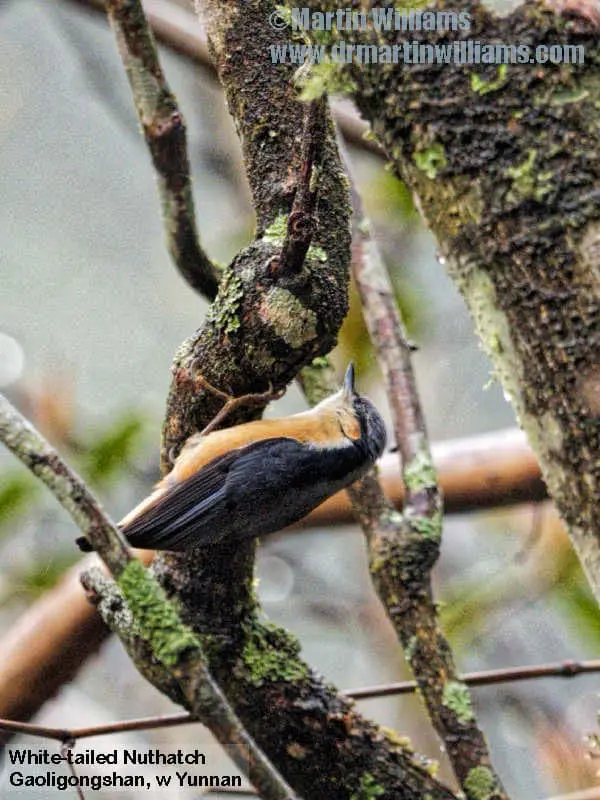
Also a few White-tailed Nutchates. So, some enjoyable birding; this was not far above Pianma. Heading higher, we found the woods seemed quieter for birds – Nutcrackers were in evidence. And the fog made it about impossible to check for Fire-tailed Myzornis at the pass: too bad!!
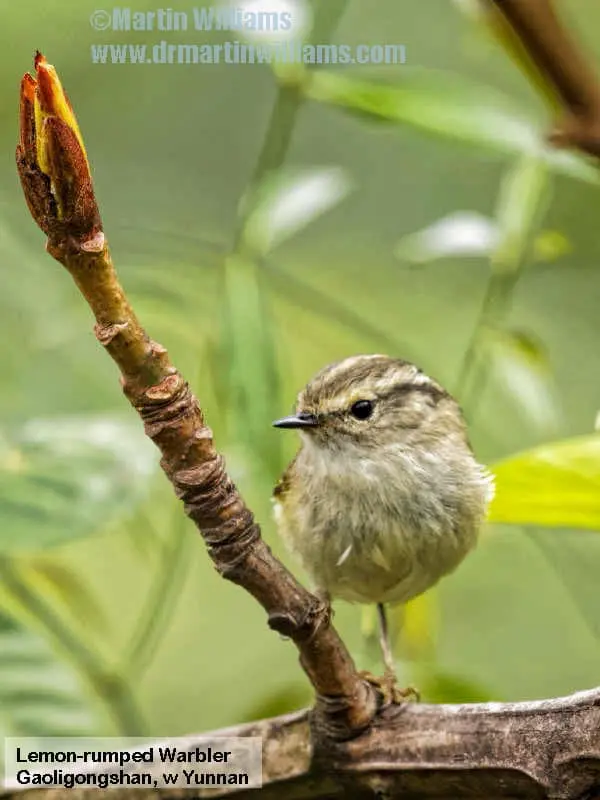
Heading down to the east again, we dropped well below the cloud – and the good forest – and stopped for lunch at a place by fields on steep hillsides, and plantations of rather thin trees. With time to spare as food was prepared, had a short walk, and proved relatively “birdy” – for small birds including Silver-eared Mesias, Lemon-rumped Warblers. Maybe at least some of these would breed at higher elevations, but yet to move up as spring still relatively cool, and often grey with rain [this year].
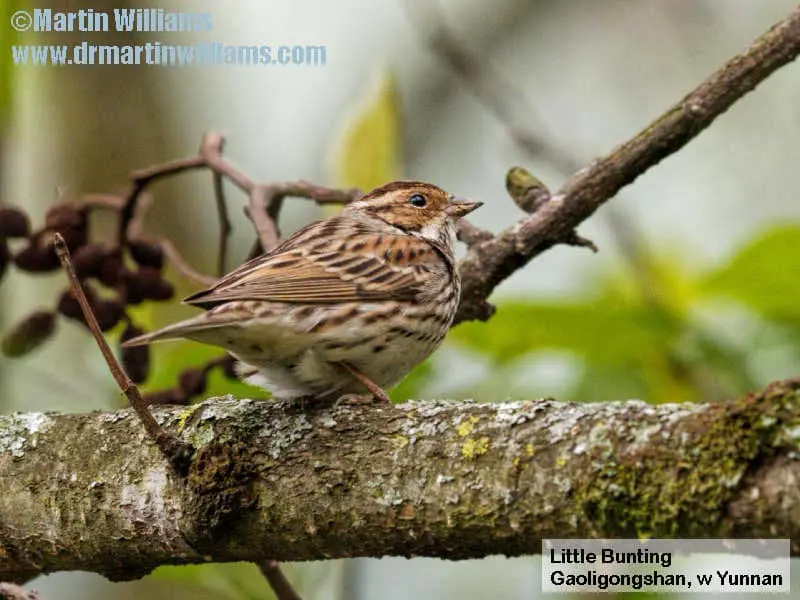
Little Buntings were winter visitors or passage migrants; this one gave good chance for photos.
Gaoligongshan Nature Park
Then, southwards, passing below Baihualing, to eventually turn up and west from the Nujiang, to [Southern] Gaoligongshan Nature Park. It was dark as we arrived, with a deluge of rain during thunderstorms, and the restaurant and reception by the car park seemed a very basic place, as if in high remote mountains.
But up a long flight of steps, the cabin-style buildings for accommodation had good rooms (with en suite bathrooms – something I’ve just read Xi Jinping failed to get in prime room in hotel during visit to the UK!). Beside this was a museum; though had no time to call in. Though it seemed no one else but a caretaker was in the vicinity, it seems there is some desire for nature tourism here; a sign listed attractions including nighttime “beast” viewing.
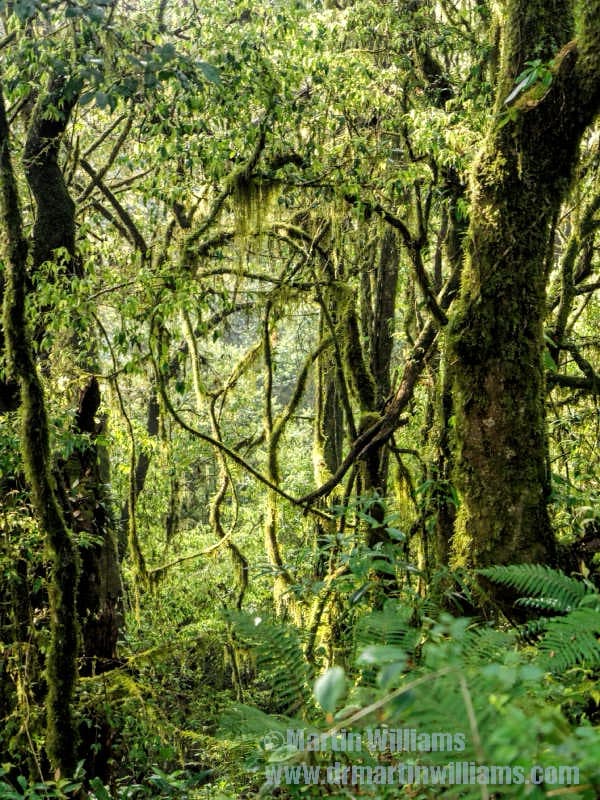
The morning was fine, and we walked a circuit through forest north of the nature park centre. There’s a good path; the forest is dense; branches are hung with mosses – to me, seemed like being in cloud forest. There’s even a gibbon viewing platform; though Hofai said that only one family of Eastern Hoolock Gibbons are in the area; the caretaker had heard gibbons the day before, but no calls heard by us.
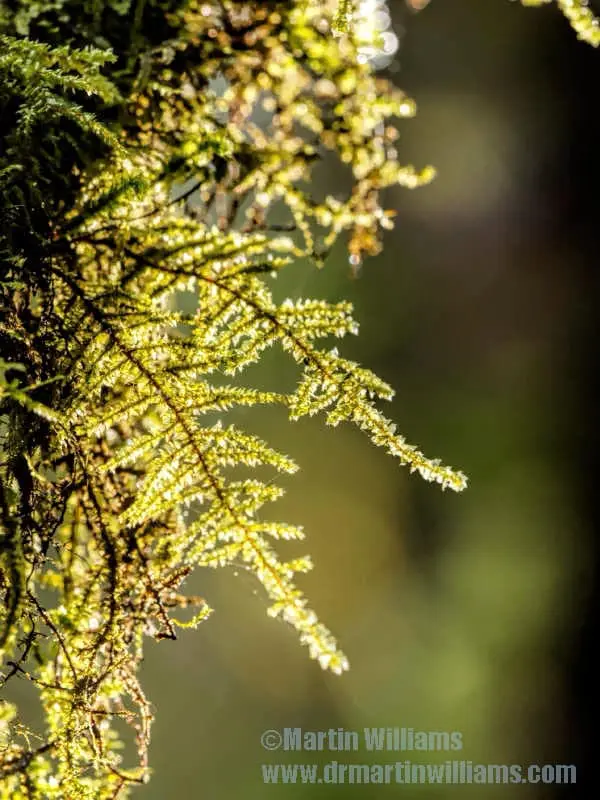
But to us, proved a place where birds were more readily heard than seen. A White-browed Flycatcher was among “trip ticks” [heck, may well have been a lifer for me]. Also had frustrating calls – a rich whistling was perhaps a laughingthrush or scimitar-babbler; a bird singing loudly from very low cover but only giving glimpses may have been a tesia. Yes, I know – should have brought a recorder to use playbacks, or maybe even prepared by bringing recordings of likely species. But, had plenty of gear, inc cameras.
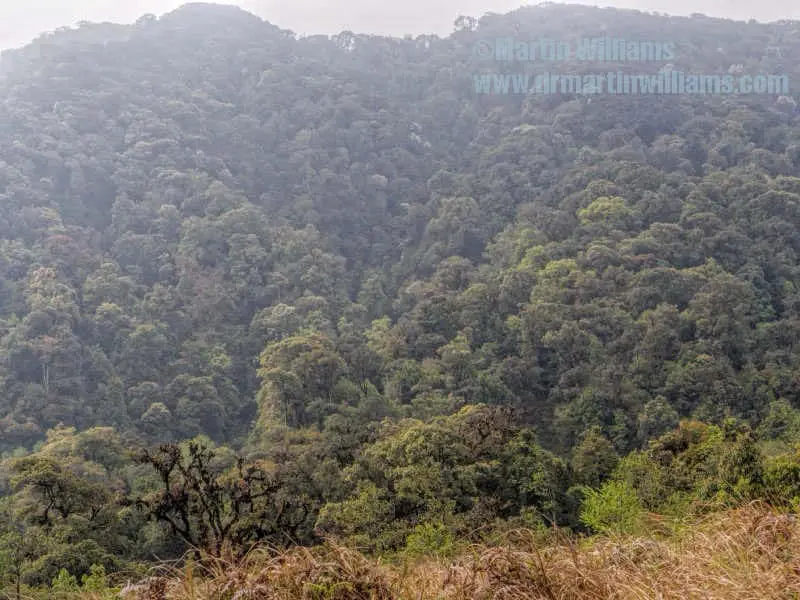
Just across the road from the park headquarters there’s a rolling, grassy area, where I was surprised to find three Oriental Skylarks. A Black Eagle and a Pacific Eagle flew low overhead; Hofail had earlier pointed out Himalayan Swiftlets, and noted that Dark-rumped Swift has been seen here – a major rarity for China. Good forest to the south of this, it seemed; I thought there were more barbets – Great and Golden-fronted – singing here than to the north.
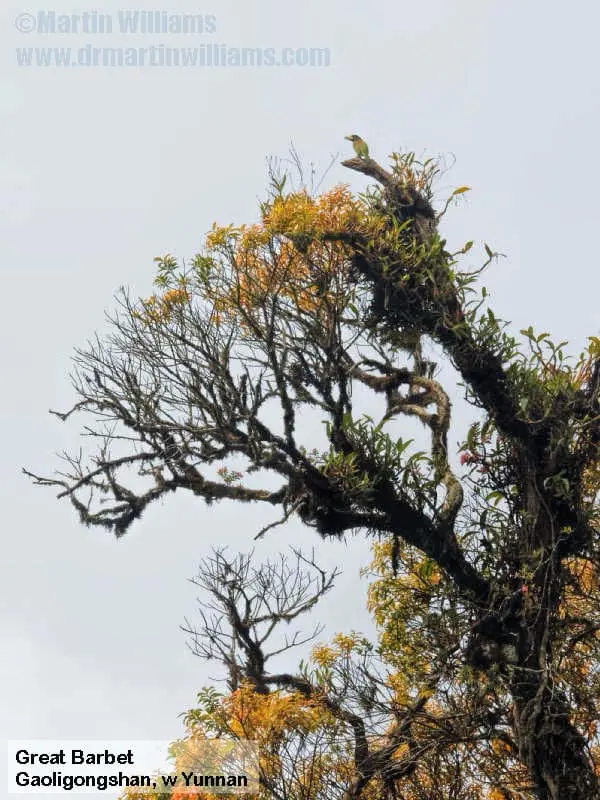
We could only spend a morning here. Drove down to west a little, and tried a rough road that led into wooded hills area: might we worth exploring. Indeed, would be good to spend more time in this area; especially for anyone who likes being somewhat off the beaten track.
Further down, below the best forest, stopped for lunch at a restaurant with good views over farmland and some woodland. Proved good for variety of birds, if not with megaticks likely, including the only Chinese Babax of our trip.
Yingjiang Sand Dredging Area
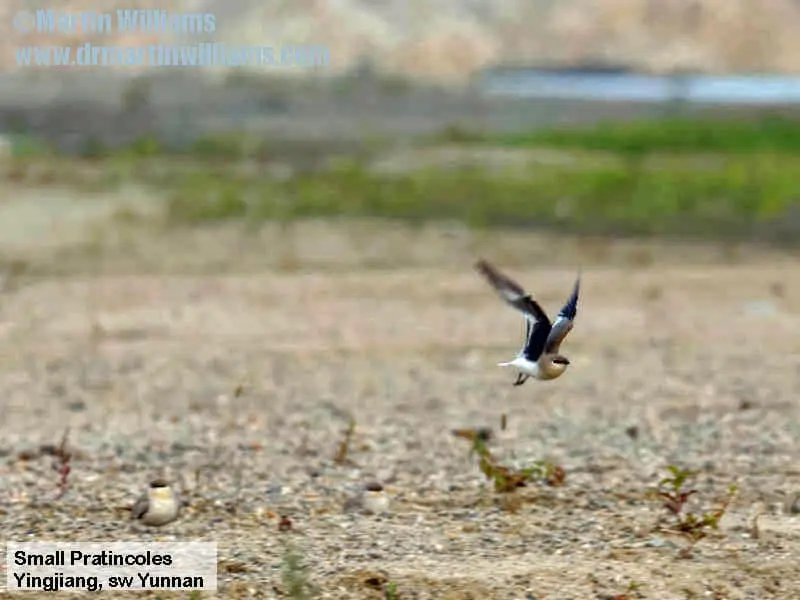
Especially for a trip in Yunnan, which has outstanding scenery, a trip to a sand dredging area might not sound too promising. But Hofai told us this place in Yingjiang – Bountiful River – county was good for birds including Small Pratincoles. Sure enough, we found the pratincoles; including parties resting on sand and gravel areas by the river.
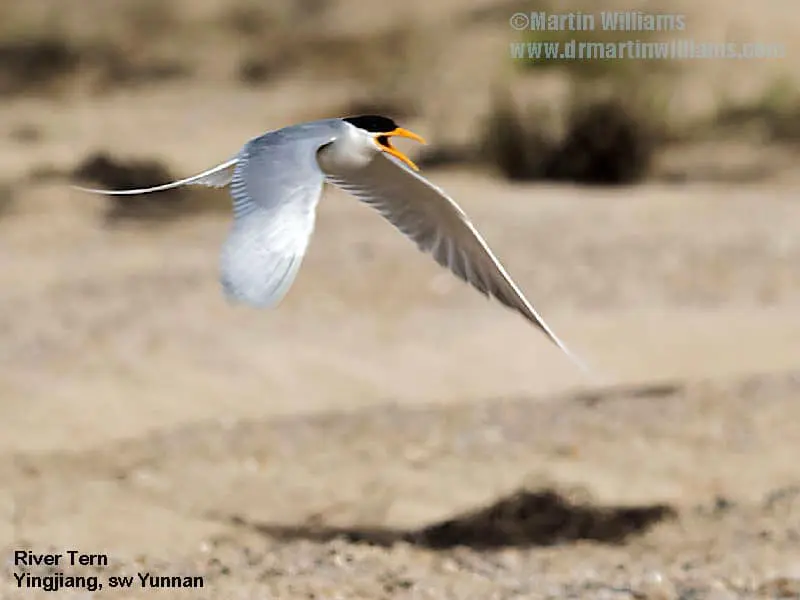
Hofai had also mentioned River Terns; and there were several of these too – some of them mobbing us as though they had nests close by.
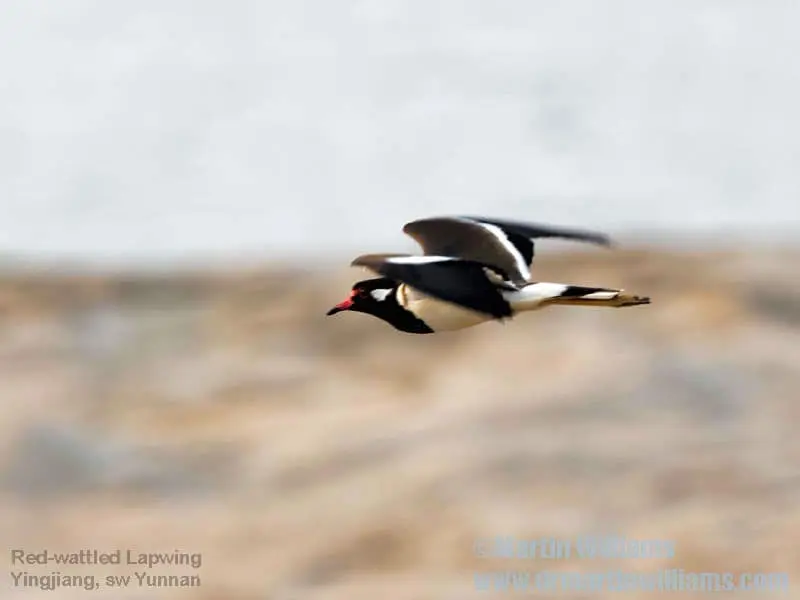
To me, Red-wattled Lapwings were a bonus.
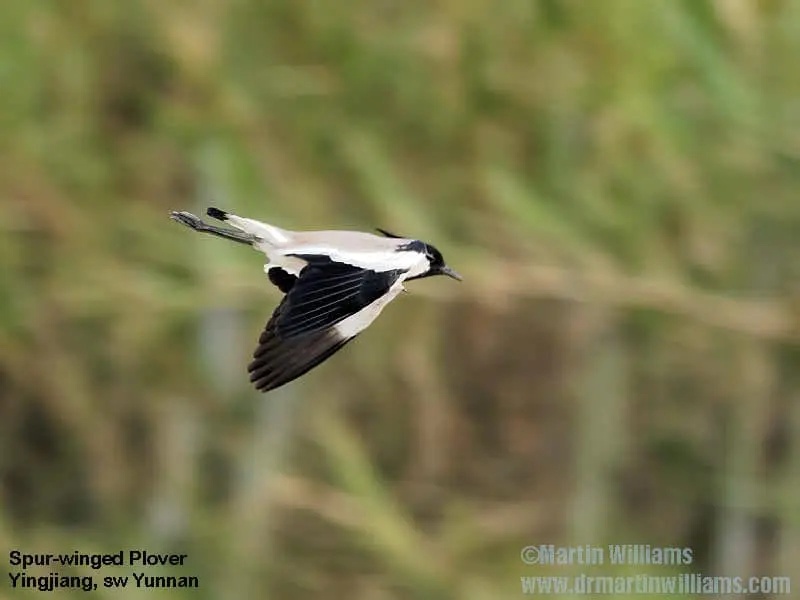
So too Spur-winged Plovers.
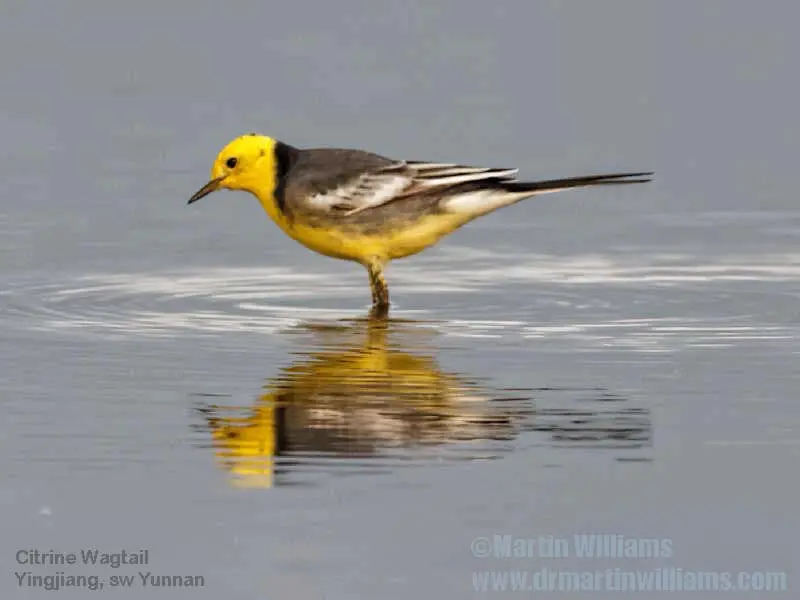
There were wagtails, too, including Citrine – which are here commoner than Yellow Wagtails (unlike, say, Hong Kong – where it’s tough to find Citrine). Other birds included a couple of Ruddy Shelduck and at least three Burmese Spot-billed Ducks.
To me, recalled gravel pits in the UK, which became perhaps unlikely birding hotspots, especially for Little Ringed Plovers that took to them as breeding sites. But here, so much more exciting birding than a regular gravel pit outing!
By the time we were set to leave, the sun was almost setting. Small Pratincoles flew overhead in a succession of flocks; I thought they must be going to roost, but at least a couple of hundred or so were over the grassy banks, whirling rapidly to chase after small insects – mosquitoes and maybe more – that emerged towards dusk. Far faster than regular pratincoles; like busy swallows.
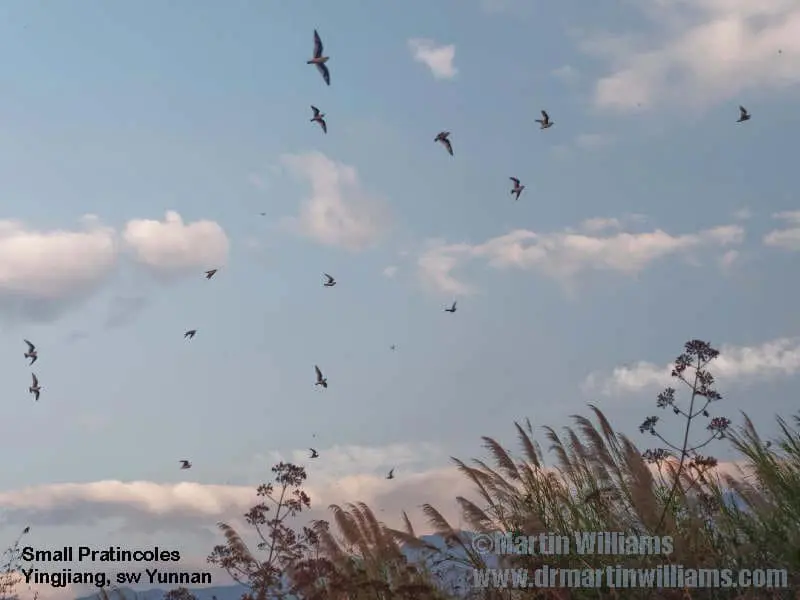
Yingjiang Fringe – Farmland
Early the next monrng, we headed to an area by a stream just on the fringe of Yingjiang town. There’s a mix of scruffy farmland – like small vegetable plots, with a little woodland include fair sized trees. Perhaps should be nothing special; yet with habitat destruction including for more intensive farming – and relative safety from trapping and hunting, so far, this is like a little oasis.
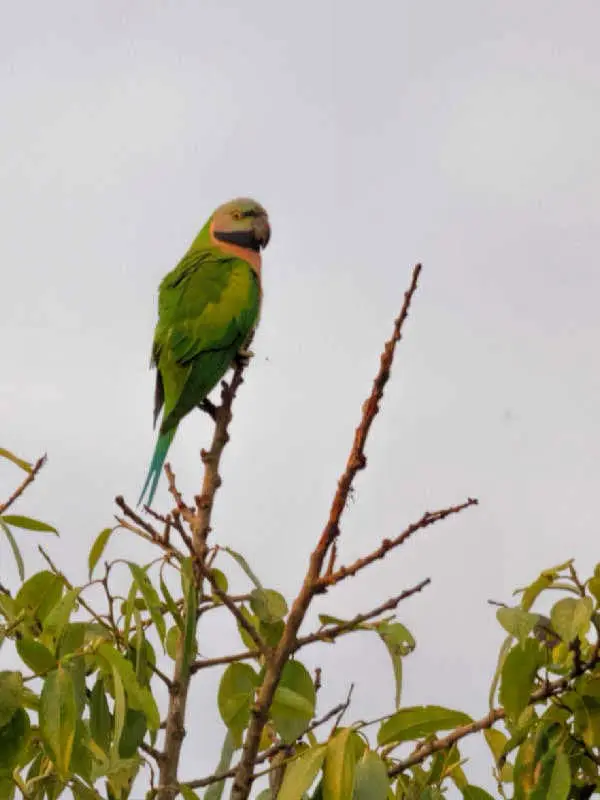
This Red-headed Parakeet proved the most readily photographed of the birds we saw, which also included Blossom-headed Parakeets, Chestnut-tailed Starlings, single White-collared and Great Mynas flying together, a small party of Common Rosefinches, Striated Grassbirds,
I was reminded of Hong Kong’s Long Valley, where there is also farmland with some slightly wild grown areas that might look unimpressive at first glance, but also attracts a great variety of birds. Maybe also parts of England with ponds, meadows, hedgerows. Simple enough mixes of habitats; yet sadly becoming rarer.
Struck me this could become a nice little nature reserve or protected area of some sort, which could benefit Yingjiang people too.
Nabang and Hornbill Valley
Then, to an area on the Burma border with Yingjiang, where we stayed at two villages: Nabang and Xima. The prime habitat here is forest; though the villages are a few hours [couple of hours or so?] drive apart, without passing through continuous forest en route, it seems this forest area is a unit, on low hills. To my eyes, it wasn’t impressive sub-tropical forest – maybe at least some was secondary growth, following past logging [??], nor any impression of great forest as I remember from Xishuangbanna in the south of Yunnan some years ago. But, with less trapping and hunting than when I went to Xishuangbanna, birding easier.
It was hot and sunny as we arrived at Nabang early afternoon. Though we checked an area by river here, birds were sparse; Hofai reckoned it was worth returning later, towards sunset. Proved correct, and had a good session there.
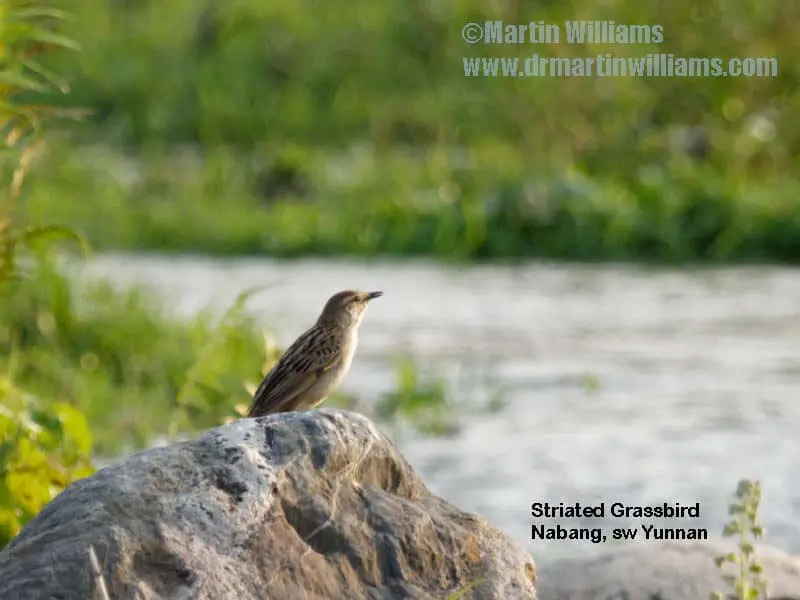
This lowland area at Nabang is deforested, but with some marshy patches grazed by buffalo, plus rank fields, fishponds, and a scattering of trees, it holds a very good diversity of birds.
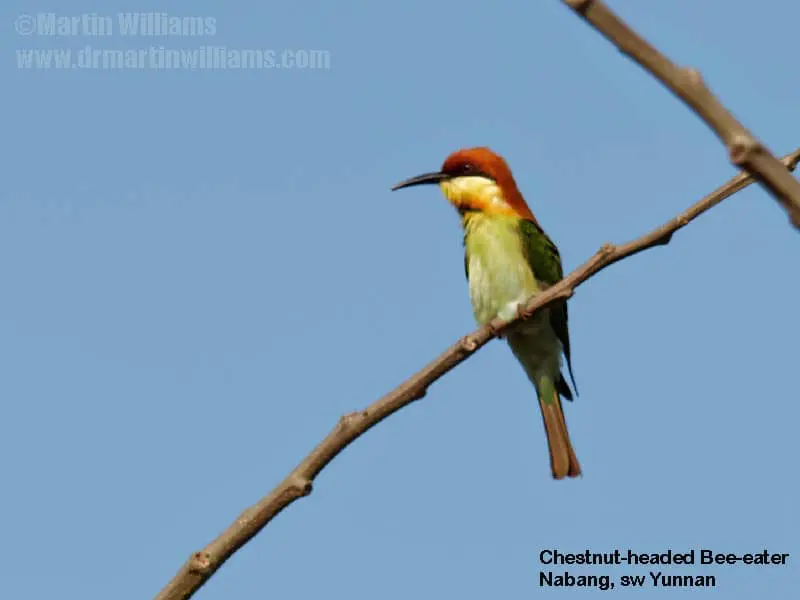
There were a few Chestnut-headed Bee-eaters. This is a site for Wire-tailed Swallow, a rarity in China with a restricted distribution; saw one, but too far away for photos.
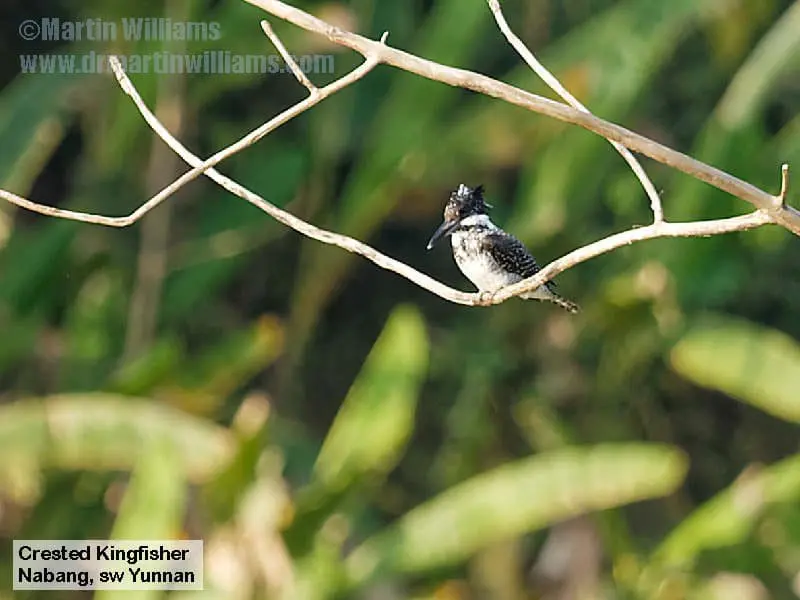
A couple of Crested Kingfishers were perched by one fishpond. Not surprisingly, no sign of an Ibisbill [!!] that had been seen along the river during the winter.
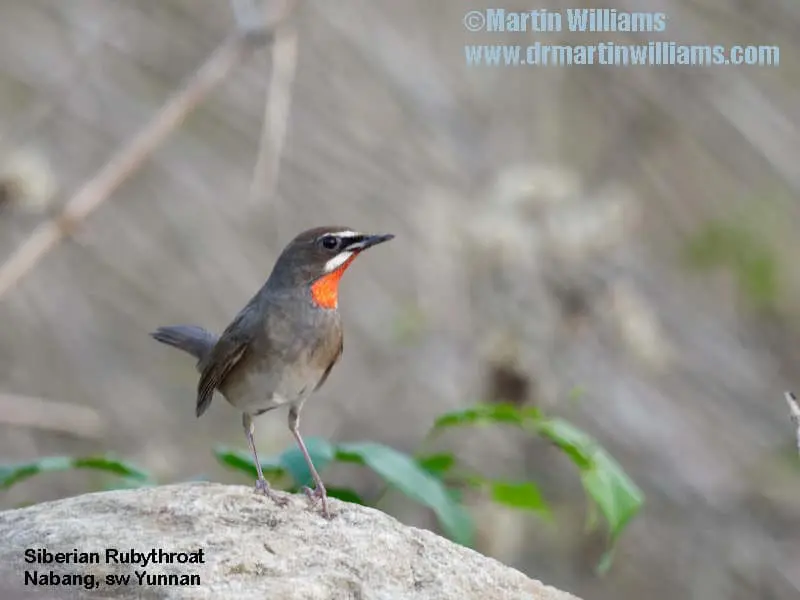
This Siberian Rubythroat hopped into view around sunset, and gave remarkably good views. Hofai saw another, so maybe they occur here as migrants.
In the morning, we went to a huge fig tree in the forest – and near the road – above Nabang. From close by, watched birds coming in to feed on its remaining fruit, or tried watching them anyway. This is almost like a “one tree forest” [as a park near Ruili is named after huge tree with several trunks; we later tried this – but you shouldn’t go, just touristy n terrible!]; has vast dense canopy, making it very hard to see birds once they’d gone inside.
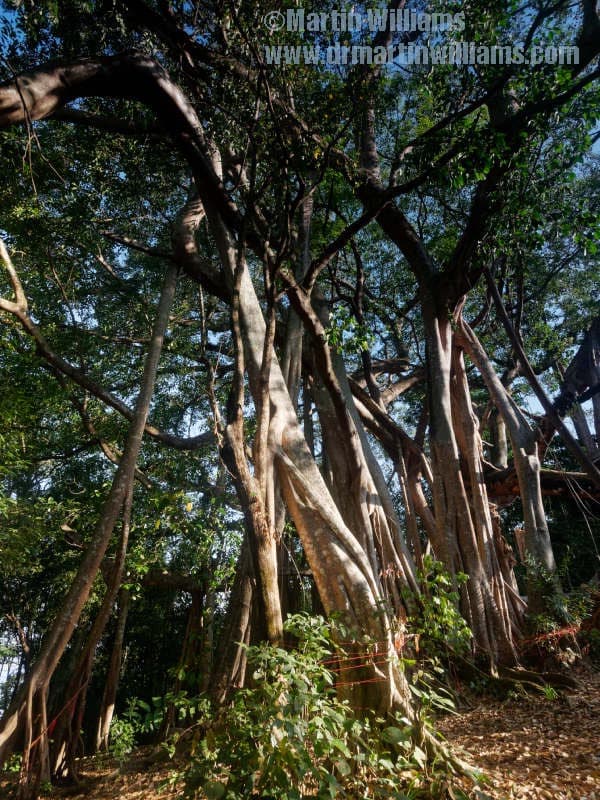
Proved fair for green pigeons, which are tough to find in China: at least 15 Mountain Imperial and 10 Pin=tailed Pigeons. It was good that Hofai had brought a telescope, as birds high in the tree were hard to see otherwise; included a Maroon Oriole.
As we were about to leave, walked under the tree; only then heard a hornbill fly off from the depths – not even seeing it.
Then, we moved again, to Hornbill Valley.
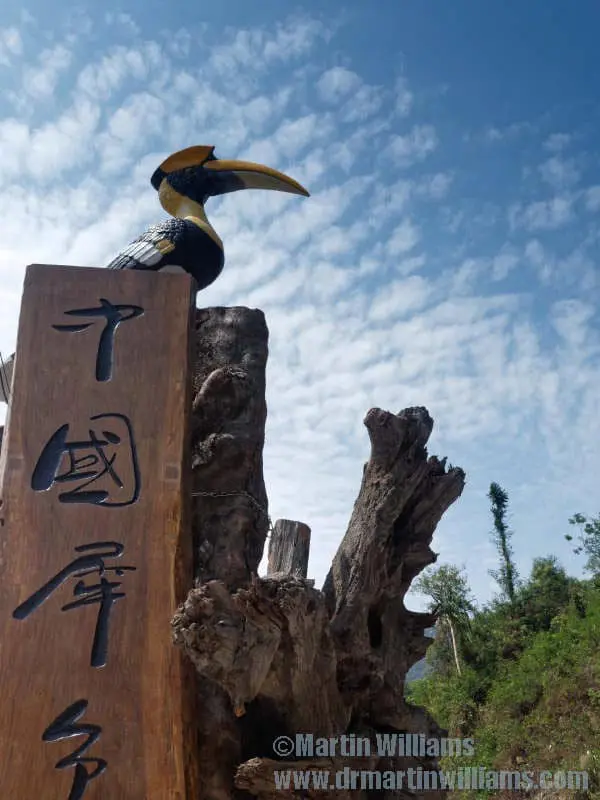
The Yinjiang County government is promiting birding and bird photography tourism – a county bird race was about to take part in the next few days; and this is one of the key places. But it seems two Great Hornbill statues atop the remnants of huge trees welcome visitors have received most of the funding put into Hornbill Valley, as it’s now known. Certainly, the village down below – where we stayed – has seen better days, with logging trucks no longer passing through and halting; a one horse town of the sort seen in Wild West movies, I thought. [Hotel so basic that Hofai told of a birding group arriving at night, and promptly returning to Nabang, only to come back to Hornbill Valley the next morning! But, we found not so bad, just toilet could use some cleaning at times, and our ceiling produced bit of a waterfall during a rainstorm…]
To me, seemed Hornbill Valley is more akin to Hornbill half-a-valley – as on Chinese side protected, maybe at least partly due to hydropower project at bottom of valley; while the other side is in Burma, and forest looked patchier there, with a marble quarry too.
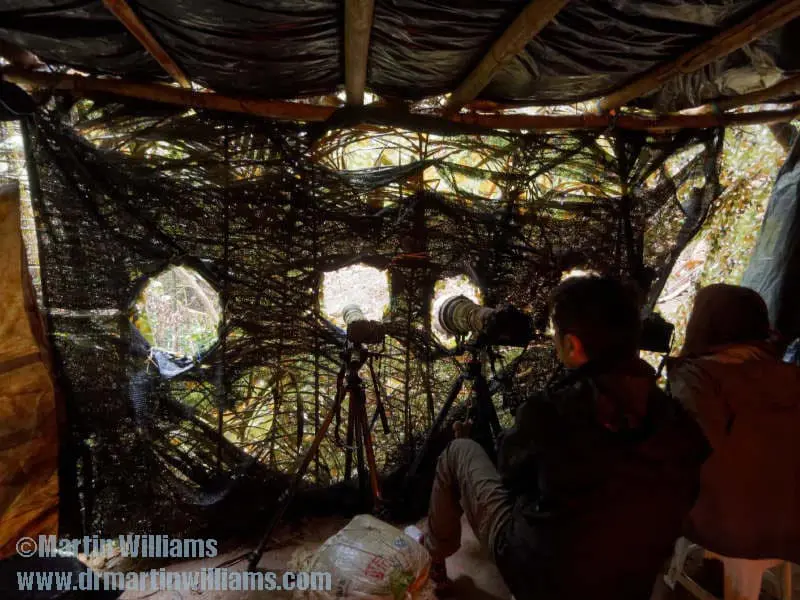
Horbill Valley farmers have learned from Baihualing about building hides by bird feeding and watering stations; Hofai booked places in this hide. But with thunderstorm pre-dawn, I opted to wait a little, have breakfast w my wife and son; then went once the rain had stopped. Oh dear, led to impressive dipping – for rain stopped after dawn, and Hofai plus this HK couple saw Blue-naped Pitta, Peacock Pheasant and Red-headed Trogon …
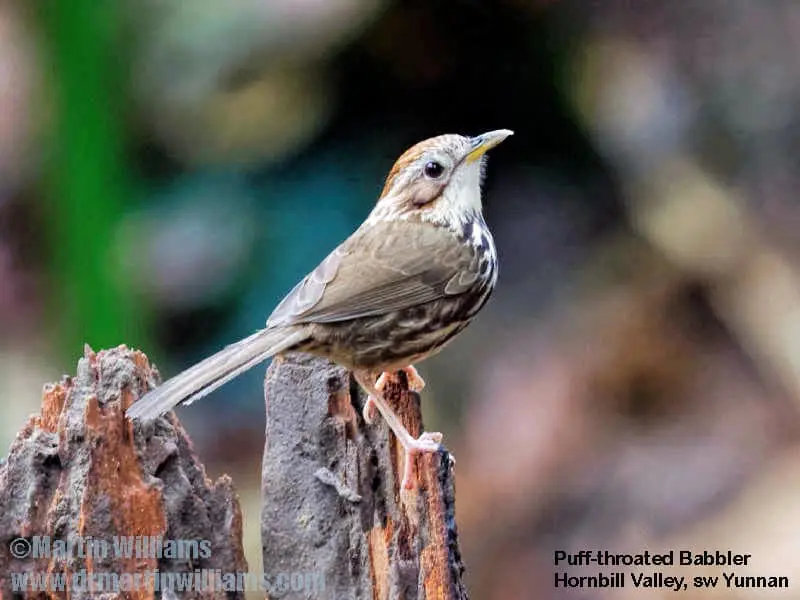
Ah well…. I did make it to the hide before mid-morning, too late for these three star birds – which tend to arrive at dawn or towards dusk. Did see and photograph some species, though; wasn’t as busy as the hide at Baihualing.
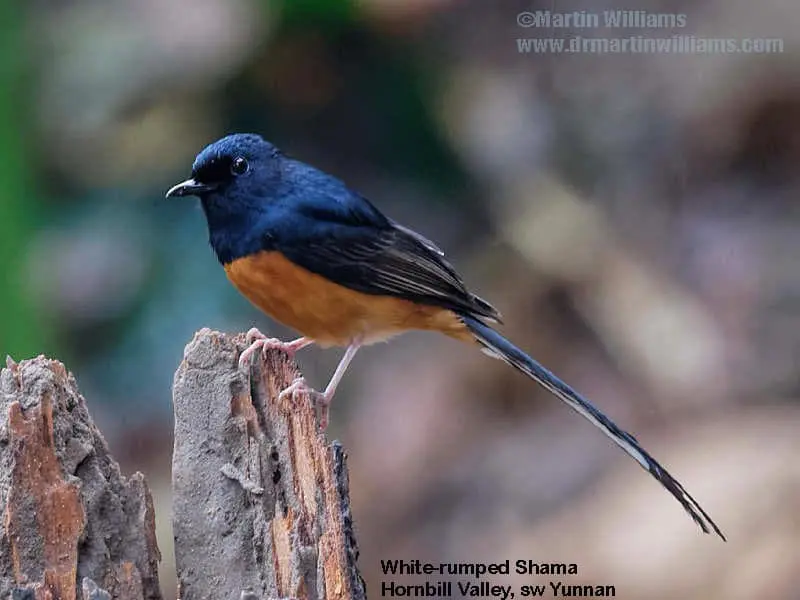
Also this White-rumped Shama; note I’ve waited till it ate a mealworm before taking shot, but it’s on, err, same post as the babbler above…
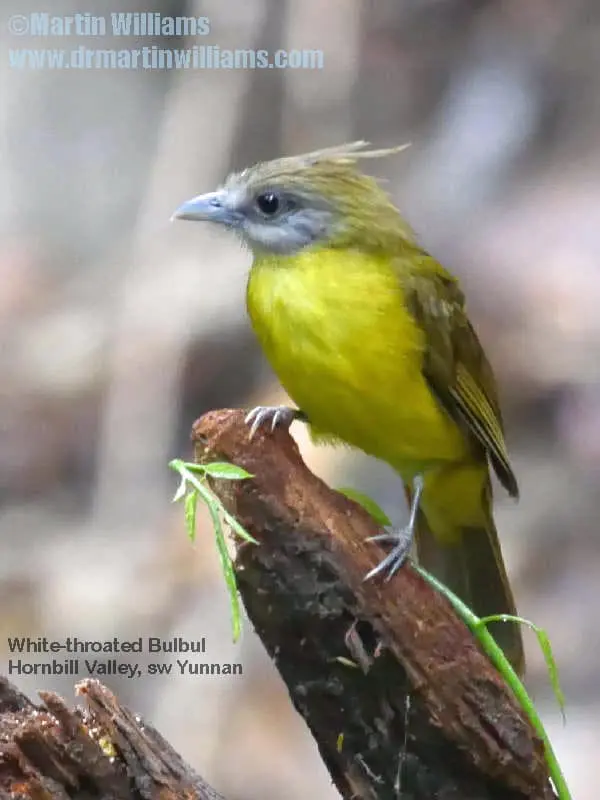
A White-throated Bulbul also posed obligingly on a post. Unusually for bulbuls, didn’t notice this species away from the hide.
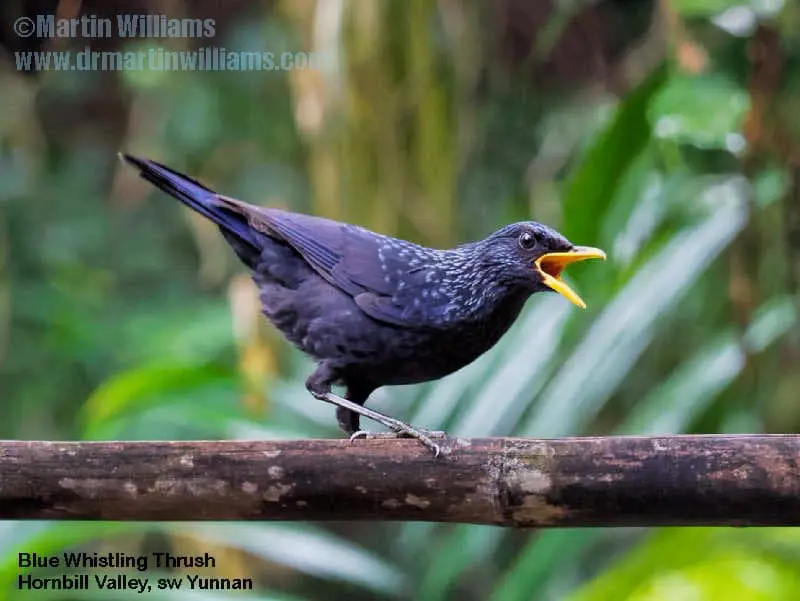
This Blue Whistling Thrush also came by for food; bright yellow bill unlike Hong Kong Violet Whistling Thrushes with their black bills; also different call [more rasping than high pitched whistling in this case]. Surely a different species.
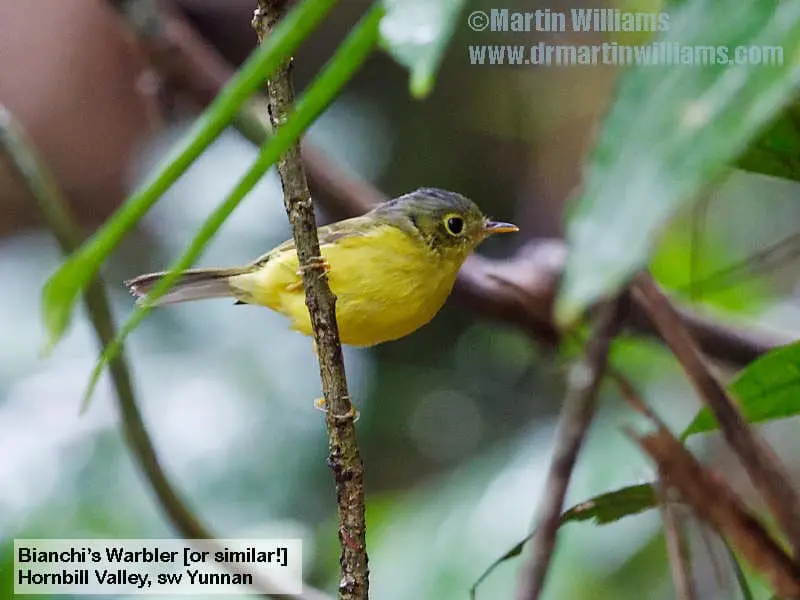
This golden-spectaled type warbler [maybe Bianchi’s] also came close, but holding territory here rather than coming for the food.
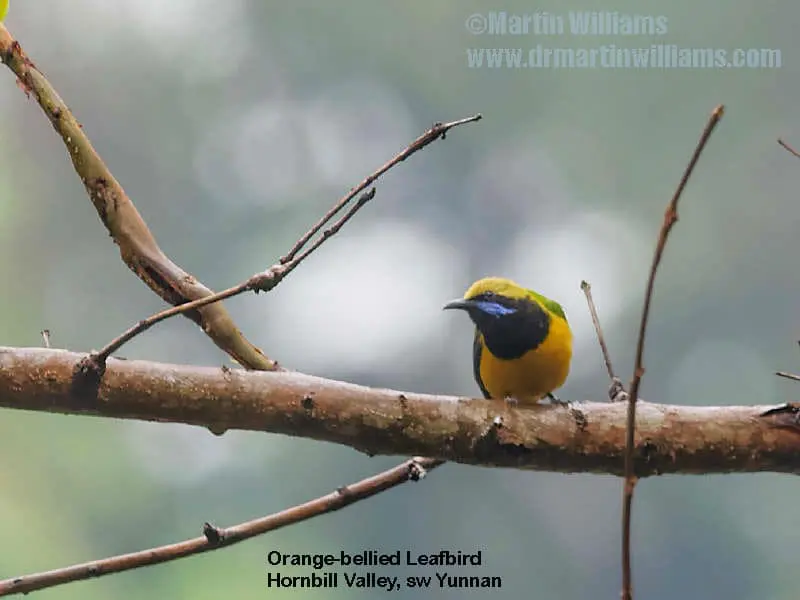
Birding the forest otherwise mostly involved walking along the winding road along the steep valley side. Challenging, as you might expect. Though there are a few “stakeouts” – including a place to wait for woodpeckers including Great Slaty to come to nest holes at dusk; waited here, and a Greater Yellow-nape came, but left before Great Slaty showed.
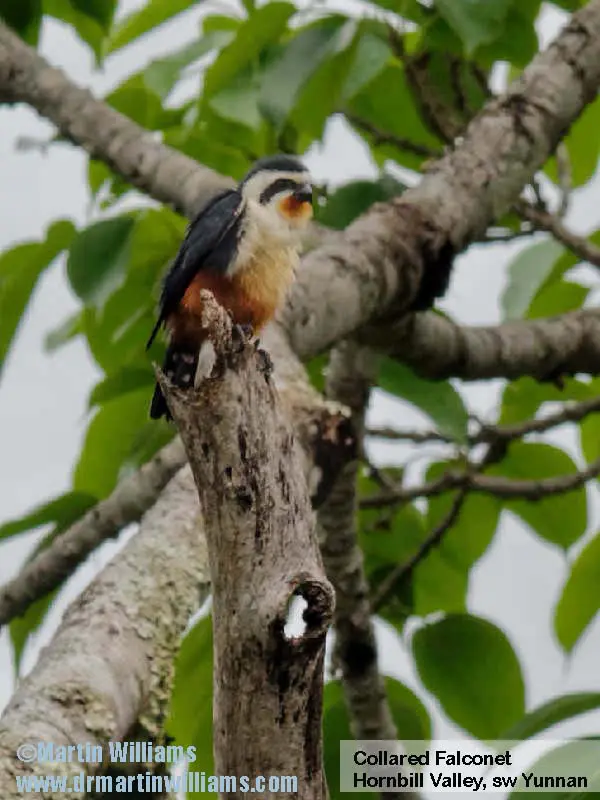
Far easier is a spot for Collared Falconet, at tiny cluster of buildings above the main village. You get out of the car, walk maybe 30 metres along a road – and there’s a viewing point, with trees on slope below; we saw pair at eye level, inc mating. Also two Great Hornbills were perched close by, but flew off before I realised and could reach for camera. Also saw a Wreathed Hornbill in distance. There was a new road being built from here to Nabang, through forest: likely to have bad impact on forest I’d think, such as for poaching; but seemed to me it could be good to walk along, or maybe drive and stop at times once it’s drivable [as we were there, surface like a skiddy mudbath!]
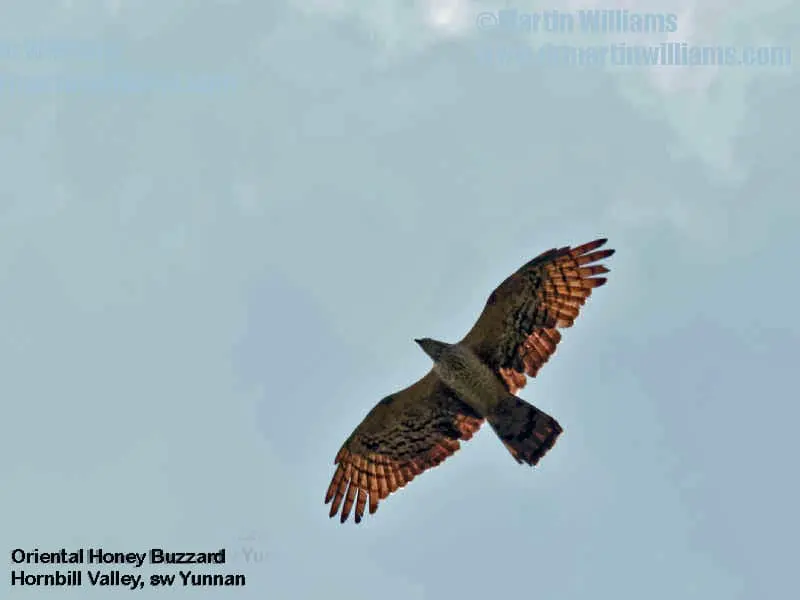
But we were out of time. Driving out of Hornbill Valley, saw Oriental Honey Buzzard [Crested Honey Buzzard] low over trees.
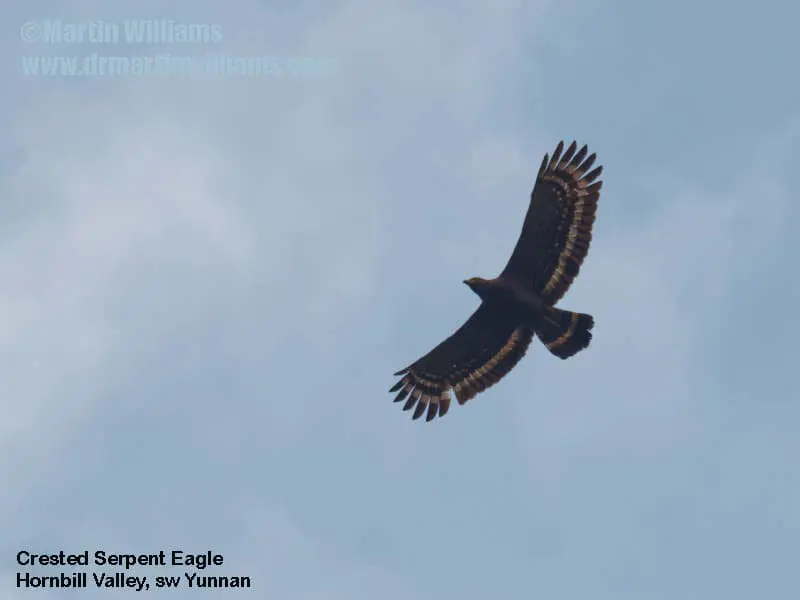
Also a Crested Serpent Eagle.
And that was pretty much the end for our birding in Yunnan; headed to Ruili, and next morning to Mangshi for flight – where Puti Temple proved wonderful to visit.
Videos from Yunnan birding trip
Birding Ecotourism Models? – and Questions, Questions
No more birding here, but a few reflections on the trip, some questions arising. Some of questions more for Yunnan based birders; maybe some know answers already.
Forest Birding Tourism Model?
At Baihualing, especially, also Hornbill Valley [maybe increasingly], local people setting up feeding and watering stations with hides for bird photographers are clearly making fair money by rural standards, some even doing well compared to many city folk. Also making bird photographers, and some birders, happy.
Might be some downsides to this. We saw a trapped squirrel at Baihualing; maybe bird photographers don’t like them competing for food, so could lead to squirrels being seen as pests, and killed. I was surprised not to see, say, Crested Goshawk: if one of these was to start frequenting the stations might it soon be targeted for trapping or simply killing?
Can wonder, too, about impacts on ecoloogy of forests; Hofai reckons birds now sparser in forests above the feeding stations at Baihualing: so have birds indeed moved? If so, maybe less of their “services” in higher forest. Can also get lop-sided benefits to species that favour the stations, while others might lose out.
But, interestingly, Hofai says few birds use the stations during breeding season; so perhaps not so dependent on artificial feeding, and diets not too unbalanced.
AND whatever the drawbacks might be, surely a way better option than – as all too often – trapping and hunting being key sources of revenue, with local people finding no value in having free flying wild birds. An issue in parts of China; far more severely in, say, much of Java.
So maybe this model of bird tourism could be beneficial elsewhere, too.
Making birds that can be tricky to see, let alone photograph, into subjects for photographers; and with word soon spreading through social media.
Where do Altitudinal Migrants Go?
As we travelled, I wondered about where migrants go, especially those from higher altitudes that mainly move to lower elevations for winter. Struck me as especially important if they move short distances, mostly.
For Gaoligongshan, say, it appears most protected land is at higher elevations; lower down may be cleared areas including fields, even places with severe erosion following deforestation. So for birds moving down for winter, or just moving when there are spells of severe cold weather (with snow), do they move only to find very few places that are even somewhat suitable for them?
– wonder if this has been considered for Gaoligongshan, say.
What About Timing of Altitudinal Migration?
Another question occurring to me; mainly as fascinated by “regular” migration. Also based on this and a few other trips, such as one to Sichuan in May when many species were clearly bound for higher altitudes as winter eased.
For instance, in spring, when do altitudinal migrants move up to their breeding grounds? We saw, for instance, Lemon-rumped Warblers and more at lower elevations, perhaps ready to move up at almost any day.
Might wonder, too, what influences timing from year to year: this was a greyer, wetter spring than normal; would this make altitudinal migrants delay returns to higher elevations? Or more influenced by temperatures?
Farmland/Wetland Reserves Worthwhile?
While we went to protected forest areas, and learned of more, seemed there was a dearth of protection of other habitats.
Non-intensive farmland, for instance; is there scope for this, to benefit birds like mynas and more that prefer open areas and scrubland? Again, might attract photographers; and maybe could manage in tandem with organic farming… A little like Hong Kong’s Long Valley.
And with all the river valleys, rice fields and former rice fields, seemed to me this sw corner of Yunnan could host a very fine wetland reserve: yet there are none, said Hofail. Maybe could include organic/non intensive rice farming, some marshes etc. I mentioned to Hofai, who was sceptical about this idea, tho thought Bronze-winged Jacana was among potential species. Perhaps Asian Openbills, now they are moving towards/into China. Sarus Cranes perhaps can’t return to Yunnan; but who knows…





